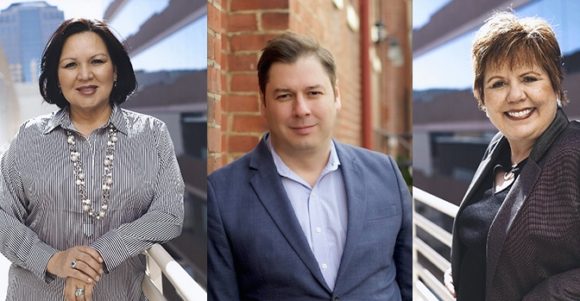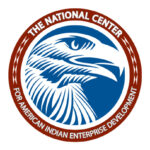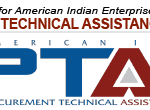A transition in leadership brings new perspective to the nonprofit organization and its Reservation Economic Summit
KRISTIN BUTLER / Indian Country Today Media Network / 19 JANUARY 2017
Click Here To View Article on indiancountrytodaymedianetwork.com
“This is a breath of fresh air to the National Center,” said Margo Gray (Osage), National Center board member, of Chris James assuming the president and CEO position this month. “We’re turning the page.”
Each time the National Center for American Indian Enterprise Development undergoes a change in leadership, the organization reevaluates and strengthens its focuses. Among those shifts will be a revitalized National Reservation Economic Summit, and enhanced follow-up.
“We’re not just doing the event, our job is supporting Indian country,” James told Indian Country Media Network. “We’re supporting our Native-owned businesses, our tribally owned businesses, and our tribal leaders nationwide. We do that every day through our headquarters, our satellite offices throughout the country, and our Procurement Technical Assistance Centers (PTACs).”
James hails from Cherokee, North Carolina, home of the Eastern Band of Cherokee Indians. His family has run small businesses on the Qualla Boundary for more than 50 years.
James first got involved with economic development in the late 1990s, when the City of Cherokee was going through a big transformation, revitalizing its downtown scene and expanding the tribe’s cultural offerings through a museum, language program and more. During that transition period, the tribe started a Community Development Financial Institution (CDFI), and James was named the associate director of the Sequoyah Fund in 2000. “We worked with small businesses, not only in Cherokee, but throughout Western North Carolina, providing micro-loans, small business loans and revitalization loans to businesses who wanted to vamp up their businesses,” James said.
In late 2008, James joined the U.S. Department of the Treasury, within the CDFI Fund, where he oversaw the Native CDFI program Native Initiatives, which provides funding to many Native CDFIs. “We have to remember in 2008 how bad our economy was. When I got up to Treasury in ’09, it was a scary time for every American and for every small business. Being a part of the support network to help our Native American businesses and our tribal businesses by providing some additional funding from the federal government — it was super exciting,” James said.
Come mid-2011, James joined the U.S. Small Business Administration (SBA), where he oversaw the Office of Native American Affairs, and then developed the Office of Intergovernmental affairs. In his final SBA role as the head of the Office of Field Operations, he managed a workforce of more than 800 people with an annual operating budget of over $200 million. “My last job at the SBA was to oversee all of our build operations — about 50 percent of the SBA’s work force, [which is] a little over 68 district offices,” James said.
In January 2017, James joined the National Center as its president and CEO. It was a natural transition for James, who has served as a liaison between Indian country and the federal government for much of his career. And James is a fierce advocate of Native business. “The National Center empowers Native Americans to create new businesses and to continue to grow business in Indian country. We have vibrant businesses and a vibrant economy,” James said, “and we are looking at [doing] innovative things in our communities.”
One way the National Center reaches budding entrepreneurs across Indian country is through Procurement Technical Assistance Centers (PTACs) across 23 states around the country. The National Center’s PTACs give Native businesses access to free services: business consulting and technical assistance on marketing and selling to federal, state, local and tribal governments and large prime contractors. Since James came on board, the National Center has re-committed to equipping Natives with the tools they need to get their businesses up and running and prosperous. “We’ll get more intimate with the types of technical assistance that we provide,” said Patricia (Pat) Parker (Choctaw), vice chairwoman of the National Center board.
Parker can personally attest to how instrumental technical assistance can be for a first-time entrepreneur. “I entered into my business as an entrepreneur with a passion, not an entrepreneur with an MBA,” said Parker, who in 1992 founded Native American Management Services (NAMS), which provides grant lifecycle training and technical assistance, along with conference and media management, for tribal communities through federal contracts. “So I had to learn business tools.”
Parker credits the SBA and RES events for making her learning curve easier, and she picked up all her marketing tips through RES matchmaking. “I owe both the SBA and the National Center a great deal of gratitude, and I am very thankful for what they’ve been able to offer small business,” Parker said.
Both Parker and Gray run SBA Native 8(a) certified companies. “It’s not an easy thing to do; it’s a very difficult, long process,” said Gray, founder and president of Margo Gray & Associates. “But we had someone we could talk to.” While James served at the SBA, the administration created SBA.gov, “a one-stop place where you could go and get the tools you need to start your business and also get into 8(a),” Gray said. “Chris was a big part of that behind the scenes.”
As board members, Parker and Gray have invested ample time in strategic planning to ensure the National Center is continually up to date to succeed in the modern business world. “The platform of technology has changed the face of doing business globally,” said Gray, who used to require an office to run her business. Now she handles everything from the palm of her hand — with her cell phone.
Refreshing RES 2017
The National Center traces its roots to Southern California in 1969. The organization’s founders sought to help struggling Native artisans, particularly in the Los Angeles area, where the American Indian Center was based. Initially called the Urban Indian Development Association, the organization changed names to the National Center for American Indian Enterprise Development in the late ’80s and relocated to Mesa, Arizona. Thirty-one years ago, it started the Reservation Economic Summit (RES). The networking event started off as a simple lunch-in, with maybe around 80 to 90 participants. Today, National RES, held annually in Las Vegas, draws nearly 5,000 attendees. This year’s summit takes place March 13-16 at the Mirage Las Vegas.
Native business has significantly grown over the nearly 50 years that the National Center has been at work. Native-owned businesses currently number slightly less than a half million nationwide. “That’s a big gain, but on a bigger scale, [compared to] other minorities, we still have some work to get done,” Gray said. “That’s why we really look to Chris’ leadership to take us to that next level.”
Although this year’s RES agenda is still in draft form, Gray said to expect an interesting new lineup of presenters. She hinted: “We don’t have to look any further than our 40 Under 40 alum.”
RES 2017 will continue to focus on core industries and topics, among them: construction, gaming, Native 8(a) companies, tribal enterprises, global outreach and international partnerships. Gray also indicated there will be some exciting changes to the business matchmaking.
New RES developments include a runway show highlighting Native art, and presentations to raise social awareness with Native celebrity hosts like Steven Paul Judd, Sterlin Harjo and Ryan Redcorn. A panel on the “Art of Business” will focus on Native filmmakers and other creative arts, Gray said.
The summit will also address how the transition of federal government will impact federal contractors. “We foresee there will be a lot of opportunities to do contracting with the federal government over the next few years, based on some of the policies that have been discussed,” James said.
James believes the National Center will continue to have strong advocates within the Trump Administration, and particularly within the White House Council on Native American Affairs. “We’re looking to continue a relationship with the federal government at every level … to make sure that Indian country and Indian country issues are at the forefront when decisions about our economies, our infrastructure, and energy are being made,” James said.
From the Qualla Boundary to the nation’s Capitol, and now on to Mesa, Arizona, James has advocated for Indian country.
“The beauty of the National Center is we have platforms for businesses to come together, to get training and to get contracts, and that’s through, of course, our Reservation Economic Summit coming up in March,” James said. “The Native Center is a resource for Native business, a partner for them, and it provides a platform for people to do business in Indian country.”











